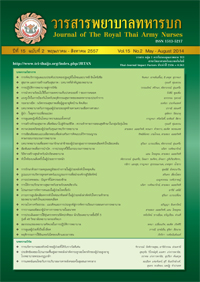การแพทย์แผนไทยกับการบริบาลมารดาหลังคลอดในชุมชนภาคกลาง Thai Traditional Medicine for Postnatal Motherin the Community of Central Region
Keywords:
มารดาหลังคลอดอยู่ไฟ, ภาคกลางการแพทย์แผนไทย, Postnatal mother, UeFai, Central region, Thai traditional medicineAbstract
การวิจัยครั้งนี้มีวัตถุประสงค์เพื่อศึกษาวัฒนธรรมการบริบาลมารดาหลังคลอด โดยการนำการแพทย์แผนไทยมาใช้ในชุมชนภาคกลาง รวบรวมความรู้เรื่องการดูแลมารดาหลังคลอดระหว่างหน่วยบริการทั้งภาครัฐและภาคประชาชน และแนวทางการใช้ภูมิปัญญาไทยและการแพทย์แผนไทยในหลักสูตรพยาบาลศาสตร์ รวมทั้งการอบรมผู้ดูแลหลังคลอด วิธีวิจัยเป็นการวิจัยเชิงคุณภาพแบบปรากฏการณ์วิทยา กลุ่มตัวอย่างเป็นมารดาหลังคลอด 25 คน บุคคลสำคัญ 24 คน ในชุมชน 4 จังหวัด คือ ราชบุรี, กาญจนบุรี, อ่างทอง และพระนครศรีอยุธยา เก็บข้อมูลด้วยการสัมภาษณ์เจาะลึกสังเกตแบบมีส่วนร่วม และสนทนากลุ่ม
ผลการศึกษาพบว่า มารดาหลังคลอดทุกรายเชื่อและได้รับความรู้เรื่องการอยู่ไฟหลังคลอดมาจากสตรีในครอบครัวสายตรง ได้แก่ แม่ ยาย ญาติผู้ใหญ่ มีการปฏิบัติตามความเชื่อที่ยังสืบต่อถึงปัจจุบันว่าการอยู่ไฟทำให้สุขภาพดี ร่างกายแข็งแรงผิวพรรณดีและมดลูกเข้าอู่ มีการประยุกต์วิธีการอยู่ไฟตามแบบเดิมในบริการสาธารณสุขแผนปัจจุบัน ผลการศึกษาจากบุคคลสำคัญยืนยันได้ว่าการอยู่ไฟเป็นวัฒนธรรมไทยที่สั่งสมมาจากบรรพบุรุษ เพื่อช่วยให้มารดาหลังคลอดฟื้นฟูสุขภาพภายหลังการตั้งครรภ์และการคลอด ส่วนความรู้เรื่องการดูแลมารดาหลังคลอดมี 5 เรื่อง คือ 1) นั่งถ่าน 2) เข้ากระโจมอบสมุนไพร 3) นวดตัว 4) ประคบด้วยลูกประคบสมุนไพร 5) ทับหม้อเกลือ ซึ่งได้นำมาบริการในระบบหลักประกันสุขภาพเป็นชุดการฟื้นฟูสุขภาพแม่หลังคลอดด้วยการแพทย์แผนไทย 4 เรื่องโดยไม่ได้ให้บริการเรื่องนั่งถ่าน แนวทางการใช้ภูมิปัญญาไทยและการแพทย์แผนไทยในหลักสูตรพยาบาลศาสตร์ทำได้ในกลุ่มวิชาเลือก 2 วิชา คือ 1) พื้นฐานการผดุงครรภ์ไทยสำหรับพยาบาล 2) ภูมิปัญญาในการดูแลหลังคลอดด้วยแพทย์แผนไทยสำหรับพยาบาล ไม่แนะนำการอบรมเรื่องการอยู่ไฟสำหรับอาสาสมัครสาธารณสุขหรือผู้ดูแลเพราะอาจมีอันตราย
ต่อผู้รับบริการ
The objective of this research were to explore the existing of cultural Thai wisdom and traditional medicine practice for post natal mother in the community of central region, to collect the knowledge of postpartum care from government and non government practices, and to study how to immerse Thai wisdom and traditional medicine practice for motherinto the nursing curriculum and training for the care giver. A qualitative phenomenology wasconducted to collect data from 25 mothers and 24 signifiant persons in the communities of 4 provinces Ratchaburi, Kanchanaburi, Angthong and Ayudthaya. Data were obtained by in-depth interview, participatory observation and focus group interview. It was found that knowledge and belief passed on within women in family. They practice “UeFai” for good health, body strengthening, fie-looking skin, return the womb to the good position. The traditional practice is adapt to the modern health care services. The signifiant persons confimed that “Ue Fai” was the Thai culture over time from past to present in order to revitalize mother’s health after pregnant and birthing. The knowledge of postpartum care was composed of 5 procedures 1) Sitting over charcoal 2) Body Herbal stream 3) Body massage 4) Herbal ball compression 5) Hot saltpot apply pressure. All practices were provided as services covered by in the National health assuranceexcept the “sitting over charcoal”. The possibility to immerse Thai wisdom and traditional medicine into nursing curriculum is employed to 2 elective courses 1) Basic principle of Thai midwifery for nurse 2) Thai wisdom for postpartum mother by traditional medicine or nurse. However, to trainhealth volunteer or care giver was not recommended because of the risk for the client.
Downloads
Downloads
How to Cite
Issue
Section
License
บทความหรือข้อคิดเห็นใดใดที่ปรากฏในวารสารพยาบาลทหารบกเป็นวรรณกรรมของผู้เขียน ซึ่งบรรณาธิการหรือสมาคมพยาบาลทหารบก ไม่จำเป็นต้องเห็นด้วย
บทความที่ได้รับการตีพิมพ์เป็นลิขสิทธิ์ของวารสารพยาบาลทหารบก
The ideas and opinions expressed in the Journal of The Royal Thai Army Nurses are those of the authors and not necessarily those
of the editor or Royal Thai Army Nurses Association.






